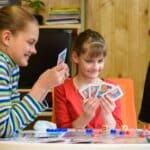Do you want to know how to teach kids growth mindset? Teaching kids a growth mindset is a valuable skill that can help them develop resilience, perseverance, and a positive attitude toward learning. Here are some strategies you can use to teach kids about growth mindset:

Explain the Concept
Start by introducing the idea of growth mindset to your child. Explain that their abilities and intelligence are not fixed traits but can be developed and improved through effort, practice, and learning from mistakes. Use relatable examples to help them understand the concept.
Praise Effort and Process
Encourage your child to focus on their effort rather than solely on the outcome. Praise their hard work, strategies they use, and the progress they make. Emphasize that mistakes and setbacks are part of the learning process and provide opportunities for growth.
Encourage Challenges
Help your child understand that challenges are opportunities to learn and grow. Encourage them to take on new and difficult tasks, even if they might initially struggle. Teach them to view challenges as exciting rather than intimidating.
Foster a Positive Attitude Towards Failure
Teach your child that failure is not a reflection of their worth or abilities, but rather a stepping stone towards improvement. Encourage them to see failures as learning experiences and to identify lessons they can take from them.
Normalize Mistakes and Failures
Teach your child that making mistakes and experiencing failure is a natural part of the learning process. Help them understand that mistakes provide valuable learning opportunities and that setbacks can be overcome with perseverance and effort.

Teach About the Brain’s Plasticity
Explain to children that their brains are like muscles that can grow and get stronger through practice and effort. This understanding can help them embrace challenges as opportunities for growth.
Encourage Problem-Solving
Encourage your child to approach problems and challenges as opportunities to learn and grow. Teach them problem-solving skills and help them develop strategies for breaking down problems into smaller, manageable parts.
Set Realistic Goals
Teach your child how to set realistic and achievable goals. Break larger goals into smaller, manageable steps, and celebrate progress along the way. This helps them develop a sense of accomplishment and motivates them to continue working towards their goals.
Encourage a Positive Inner Dialogue
Help your child develop a positive inner dialogue by teaching them to challenge negative thoughts and replace them with positive and constructive ones. Teach them to reframe challenges and setbacks as opportunities for growth and learning.
Foster a Love for Learning
Help your child develop a love for learning by exploring their interests and providing them with opportunities to explore new subjects and activities. Encourage curiosity, creativity, and exploration.
Model a Growth Mindset
Children often learn by observing their parents and caregivers. Demonstrate a growth mindset in your own actions and language. Share stories of how you overcame challenges and highlight the effort and perseverance it took to succeed.
Teach Self-Reflection
Help your child develop self-awareness by encouraging self-reflection on their own learning and progress. Ask questions like, “What did you learn from this?” or “What strategies could you try next time?” This helps them recognize their strengths and areas for improvement.
Provide Constructive Feedback
When offering feedback, focus on specific aspects of their work or effort rather than making generalized statements. Encourage them to see feedback as an opportunity to grow and improve, rather than as criticism.
Emphasize the Power of “Yet”
Teach your child to add the word “yet” to their statements when faced with challenges or setbacks. For example, “I don’t understand this… yet.” This small addition can help shift their mindset from a fixed view to a growth-oriented one.
Cultivate a Love for Learning
Help your child develop a curiosity and passion for learning. Encourage them to explore their interests, try new things, and pursue activities that challenge and engage them.
Set Realistic Goals
Teach your child how to set realistic and achievable goals. Break larger goals into smaller, manageable steps, and celebrate progress along the way. This helps them develop a sense of accomplishment and motivates them to continue working towards their goals.
Remember that teaching a growth mindset is an ongoing process. Be patient, provide support, and celebrate your child’s efforts and achievements along the way.

Do you have any other tips on how to teach kids growth mindset?
Photo Credit: Pixabay






